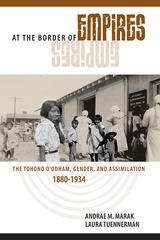
256 pages, 6 x 9
7 photos, 3 illustrations
Paperback
Release Date:01 May 2016
ISBN:9780816534203
Capture These Indians for the Lord
Indians, Methodists, and Oklahomans, 1844-1939
By Tash Smith
The University of Arizona Press
In 1844, on the heels of the final wave of the forced removal of thousands of Indians from the southern United States to what is now Oklahoma, the Southern Methodist Church created a separate organization known as the Indian Mission Conference to oversee its missionary efforts among the Native communities of Indian Territory. Initially, the Church conducted missions as part of the era’s push toward assimilation. But what the primarily white missionaries quickly encountered was a population who exerted more autonomy than they expected and who used Christianity to protect their culture, both of which frustrated those eager to bring Indian Territory into what they felt was mainstream American society.
In Capture These Indians for the Lord, Tash Smith traces the trajectory of the Southern Methodist Church in Oklahoma when it was at the frontlines of the relentless push toward western expansion. Although many Native people accepted the missionaries’ religious practices, Smith shows how individuals found ways to reconcile the Methodist force with their traditional cultural practices. When the white population of Indian Territory increased and Native sovereignty came under siege during the allotment era of the 1890s, white communities marginalized Indians within the Church and exploited elements of mission work for their own benefit.
Later, with white indifference toward Indian missions peaking in the early twentieth century, Smith explains that as the remnants of the Methodist power weakened, Indian membership regained control and used the Church to regenerate their culture. Throughout, Smith explores the complex relationships between white and Indian community members and how these phenomena shaped Methodist churches in the twentieth century.
In Capture These Indians for the Lord, Tash Smith traces the trajectory of the Southern Methodist Church in Oklahoma when it was at the frontlines of the relentless push toward western expansion. Although many Native people accepted the missionaries’ religious practices, Smith shows how individuals found ways to reconcile the Methodist force with their traditional cultural practices. When the white population of Indian Territory increased and Native sovereignty came under siege during the allotment era of the 1890s, white communities marginalized Indians within the Church and exploited elements of mission work for their own benefit.
Later, with white indifference toward Indian missions peaking in the early twentieth century, Smith explains that as the remnants of the Methodist power weakened, Indian membership regained control and used the Church to regenerate their culture. Throughout, Smith explores the complex relationships between white and Indian community members and how these phenomena shaped Methodist churches in the twentieth century.
Immersing oneself deeply in state, federal, and church archives requires much nerve and self-discipline, which always produces new visions of a complex, often neglected past. Tash Smith accomplishes this in his deeply researched book.’—Robert Keller, author of American Indians and National Parks‘A uniquely intriguing story of give and take between dissimilar parties, neither of whom remained wholly unaffected by each other or the world in which they lived.’ – Courtney Crowley, Panhandle Plains Historical Review
Immersing oneself deeply in state, federal, and church archives requires much nerve and self-discipline, which always produces new visions of a complex, often neglected past. Tash Smith accomplishes this in his deeply researched book.’—Robert Keller, author of American Indians and National Parks‘A uniquely intriguing story of give and take between dissimilar parties, neither of whom remained wholly unaffected by each other or the world in which they lived.’ – Courtney Crowley, Panhandle Plains Historical Review
Tash Smith has made an important contribution not only to the history of American Methodism, but also to the history of Oklahoma and the religious life of its Native American peoples.’—Robert L. Dorman, author of Hell of a Vision: Regionalism and the Modern American West
Tash Smith has made an important contribution not only to the history of American Methodism, but also to the history of Oklahoma and the religious life of its Native American peoples.’—Robert L. Dorman, author of Hell of a Vision: Regionalism and the Modern American West
This well-researched, engaging story enriches histories of missionary work among Indian peoples and helps explain the tension between the creation of peoples whose religious lives were, according to some, in need of the power of 'civilization' and 'uplift' that could be found in Christianity.’—Choice
This well-researched, engaging story enriches histories of missionary work among Indian peoples and helps explain the tension between the creation of peoples whose religious lives were, according to some, in need of the power of 'civilization' and 'uplift' that could be found in Christianity.’—Choice
An important book. Critical studies of Methodist missionary efforts among Native Americans are in short supply—and mostly outdated in light of significant research on Christianity and American Indians.’—Methodist History Book Review
‘Smith provides a carefully researched and engaging history of the Indian Mission Conference (IMC) in Indian Territory and Oklahoma.’—Great Plains Quarterly
An important book. Critical studies of Methodist missionary efforts among Native Americans are in short supply—and mostly outdated in light of significant research on Christianity and American Indians.’—Methodist History Book Review
‘Smith provides a carefully researched and engaging history of the Indian Mission Conference (IMC) in Indian Territory and Oklahoma.’—Great Plains Quarterly
Tash Smith provides a fresh and rich window into Southern Methodism's Indian missions as Oklahoma came to statehood at the turn of the twentieth century. A finely researched and nicely crafted book.’—International Bulletin of Missionary Research
Tash Smith provides a fresh and rich window into Southern Methodism's Indian missions as Oklahoma came to statehood at the turn of the twentieth century. A finely researched and nicely crafted book.’—International Bulletin of Missionary Research
Tash Smith is an assistant professor of history at St. Gregory’s University in Shawnee, Oklahoma.









